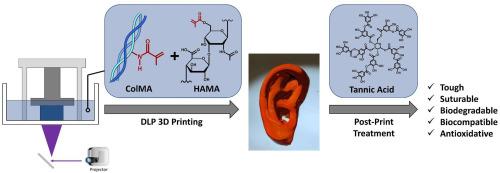一种基于胶原蛋白的生物材料墨水,用于通过打印后单宁酸处理的坚韧双交联水凝胶的数字光处理3D打印
Q1 Computer Science
引用次数: 0
摘要
用于数字光处理(DLP) 3D打印的胶原基生物材料墨水由于其固有的生物相容性、细胞粘附性和可生物降解性而特别具有吸引力。然而,在不使用合成共单体或专用打印设备的情况下,胶原蛋白基生物材料油墨的例子相对较少。此外,光交联胶原蛋白水凝胶往往易碎,限制了它们在生物医学和再生医学中的应用。在这项研究中,我们提出了一种用于DLP 3D打印的新型胶原基生物材料墨水的开发,通过打印后单宁酸(TA)处理,可以制造出坚固的水凝胶结构。该生物材料墨水由甲基丙烯酸胶原蛋白(ColMA)和天然共聚物甲基丙烯酸透明质酸(HAMA)组成,可实现仿生结构的高分辨率打印。打印后的TA处理(0.25-30 mg/mL)显著提高了机械强度,提高了降解率,并减小了双交联混合网络结构的尺寸和孔隙率。使用成人真皮成纤维细胞评估这些结构的生物相容性,揭示了低TA浓度(0-0.25 mg/mL)下的最佳细胞活力和粘附性。此外,对ta处理的生物材料的抗氧化能力进行了评估,证明了其在高活性氧(ROS)环境中的应用潜力。总的来说,这种基于胶原蛋白的生物材料墨水和打印后的TA处理为DLP 3D打印坚韧、可生物降解和生物相容性结构提供了一个有前途的解决方案,可用于再生医学的生物医学应用。本文章由计算机程序翻译,如有差异,请以英文原文为准。

A collagen-based biomaterial ink for the digital light processing 3D printing of tough, dual-crosslinked hydrogels via post-print tannic acid treatment
Collagen-based biomaterial inks for digital light processing (DLP) 3D printing are particularly attractive due to their inherent biocompatibility, cell-adhesion properties, and biodegradability. However, there have been relatively few examples of collagen-based biomaterial inks without the use of synthetic co-monomers or specialized printing equipment. Furthermore, photo-crosslinked collagen hydrogels are often brittle, limiting their use in biomedical applications and regenerative medicine. In this study, we present the development of a novel collagen-based biomaterial ink for DLP 3D printing, enabling the fabrication of robust hydrogel constructs through a post-print tannic acid (TA) treatment. The biomaterial ink, composed of collagen methacrylate (ColMA) and a natural co-monomer, hyaluronic acid methacrylate (HAMA), achieves high-resolution printing of biomimetic structures. The post-print TA treatment (0.25–30 mg/mL) significantly increases mechanical strength, improves degradation rates, and reduces the size and porosity of the resulting dual-crosslinked, hybrid network structures. The biocompatibility of these constructs was assessed using adult human dermal fibroblasts, revealing optimal cell viability and adhesion at low TA concentrations (0–0.25 mg/mL). Furthermore, the antioxidant capacity of TA-treated biomaterials was evaluated, demonstrating potential for applications in environments with high reactive oxygen species (ROS). Overall, this collagen-based biomaterial ink and post-print TA treatment offers a promising solution for the DLP 3D printing of tough, biodegradable, and biocompatible constructs for biomedical applications in regenerative medicine.
求助全文
通过发布文献求助,成功后即可免费获取论文全文。
去求助
来源期刊

Bioprinting
Computer Science-Computer Science Applications
CiteScore
11.50
自引率
0.00%
发文量
72
审稿时长
68 days
期刊介绍:
Bioprinting is a broad-spectrum, multidisciplinary journal that covers all aspects of 3D fabrication technology involving biological tissues, organs and cells for medical and biotechnology applications. Topics covered include nanomaterials, biomaterials, scaffolds, 3D printing technology, imaging and CAD/CAM software and hardware, post-printing bioreactor maturation, cell and biological factor patterning, biofabrication, tissue engineering and other applications of 3D bioprinting technology. Bioprinting publishes research reports describing novel results with high clinical significance in all areas of 3D bioprinting research. Bioprinting issues contain a wide variety of review and analysis articles covering topics relevant to 3D bioprinting ranging from basic biological, material and technical advances to pre-clinical and clinical applications of 3D bioprinting.
 求助内容:
求助内容: 应助结果提醒方式:
应助结果提醒方式:


